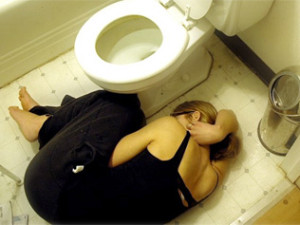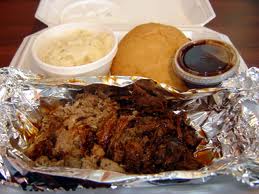Amy is a carnivore. First time I went to dinner at her place, almost four years ago, we couldn’t decide what to eat. Eventually, Amy said, let’s go to the supermarket, get a couple of steaks, and grill at home.
 I was in love.
I was in love.
Amy’s grill (right) served us well, but the years took its toll. So we splurged and got a new BBQ – the Weber Genesis — which I used for the first time last night. Whenever we get a new car, or grill, or pretty much anything, since I insist on owning things for 10 years until they are completely spent, I marvel at the technological advances. It was awesome.
We grill meat and vegetables pretty much every day. And maybe it’s not so cool after last weeks tragic story of E. coli O157:H7 victim Stephanie Smith, but we eat hamburgers – make them at home from ground beef and turkey.
The news is confusing: The N.Y. Times feature by Michael Moss that started the latest round of confusion said hamburger trim was mixed together from all sorts of places and no one wanted to test for E. coli O157:H7 (that’s what happens with a zero tolerance policy; don’t test, don’t tell). Subsequently the Times said in an editorial that the only way to be safe was to cook hamburger to shoe leather, and former Centers for Disease Control-type, Richard Bessler told Diane Sawyer on Good Morning America the only way to cook meat safely is to "cook it to the point where most people wouldn’t want to eat it."
 Former U.S. Department of Agriculture Undersecretary for Food Safety, Richard Raymond, responded on his blog that the Times story simplified a few things about testing and mixing, and that, “raw meat and raw poultry should not be considered to be pathogen free—ever.”
Former U.S. Department of Agriculture Undersecretary for Food Safety, Richard Raymond, responded on his blog that the Times story simplified a few things about testing and mixing, and that, “raw meat and raw poultry should not be considered to be pathogen free—ever.”
Then yesterday, the Minnesotans, home of Cargill, tried to poke a few more holes in the Times story.
Craig Hedberg, professor of environmental health sciences at the University of Minnesota, said,
“Testing of product, either raw materials or finished products, is something that has limited usefulness. We can’t test every square inch of an animal’s carcass to see if there’s bacteria present … it just would be too expensive.”
I’m not sure who we is, and playing cost off against human health is never a good tactic.
Ryan Cox, professor of meat science at the University of Minnesota said,
“If you were to go into a modern meat facility, it looks very similar to a surgical suite in a hospital.”
Especially with the sick people.
Cox explained that meat industry practices are so stringently regulated that “to infer in some way that we have an unsafe system would be certainly an error.”
(1).jpg) Pete Nelson , who spent 35 years running a USDA-inspected facility, defended the multiple sourcing used by large processing plants. He cited the need for a steady supply of beef in case an individual slaughterhouse is not able to deliver on time, as well as the need for a variety of meats to ensure consistency. …
Pete Nelson , who spent 35 years running a USDA-inspected facility, defended the multiple sourcing used by large processing plants. He cited the need for a steady supply of beef in case an individual slaughterhouse is not able to deliver on time, as well as the need for a variety of meats to ensure consistency. …
Both Nelson and Cox said consumers have an important role in food safety, especially in the handling and cooking of raw meats.
“We both agree on the fact that there really wouldn’t have been much of a story to begin with, particularly with the instance [The New York Times] cited with the food sickness, if the product had been cooked to the correct internal temperature.
Ouch. Blame the consumer. USDA stopped that in 1994.
Cross-contamination is a serious issue, as repeatedly pointed out on this blog and in our research, and that’s why pathogen loads have to be reduced as much as possible before entering a further processing plant, a restaurant, a grocery store or someone’s kitchen. And then, as Raymond says, never assume meat – or any raw food – is pathogen free. Same with animals. Those 90 kids that got sick with E. coli O157:H7 at a petting zoo in the U.K. weren’t dealing with meat from different sources.
And no one has to cook to shoe leather. Meat thermometers can help, and stick it in until 160F for hamburger.
Our steaks were a delicious 125F, climbing to about 135F over time.
 planned first day of school on Wednesday because of a “significant number of students and staff who were ill.”
planned first day of school on Wednesday because of a “significant number of students and staff who were ill.”
 Palatine.
Palatine. eastern seaboard of New Holland. The Brits viewed the settlement as necessary because of the loss of the 13 colonies in North America. The locals didn’t think it was that necessary.
eastern seaboard of New Holland. The Brits viewed the settlement as necessary because of the loss of the 13 colonies in North America. The locals didn’t think it was that necessary. summer, they go a little nuts about the Christmas thing, with surfin’ Santa’s and shrimp on the barbie by the beach.
summer, they go a little nuts about the Christmas thing, with surfin’ Santa’s and shrimp on the barbie by the beach. eating food purchased at the church. More than 300 plates of food were sold, and many people bought barbeque in bulk for freezing and later use.”
eating food purchased at the church. More than 300 plates of food were sold, and many people bought barbeque in bulk for freezing and later use.” Easter break, medics are warning that half-cooked hamburgers and barely-warmed-through bratwursts can cause digestion disaster.”
Easter break, medics are warning that half-cooked hamburgers and barely-warmed-through bratwursts can cause digestion disaster.” they are cooking – but it was another standard line in the blame-the-consumer approach to food safety risk reduction.
they are cooking – but it was another standard line in the blame-the-consumer approach to food safety risk reduction. The bass player, tired of the band angst, says, “I just want to go get some barbeque.”
The bass player, tired of the band angst, says, “I just want to go get some barbeque.”
 I was in love.
I was in love.(1).jpg) Pete Nelson , who spent 35 years running a USDA-inspected facility, defended the multiple sourcing used by large processing plants. He cited the need for a steady supply of beef in case an individual slaughterhouse is not able to deliver on time, as well as the need for a variety of meats to ensure consistency. …
Pete Nelson , who spent 35 years running a USDA-inspected facility, defended the multiple sourcing used by large processing plants. He cited the need for a steady supply of beef in case an individual slaughterhouse is not able to deliver on time, as well as the need for a variety of meats to ensure consistency. …